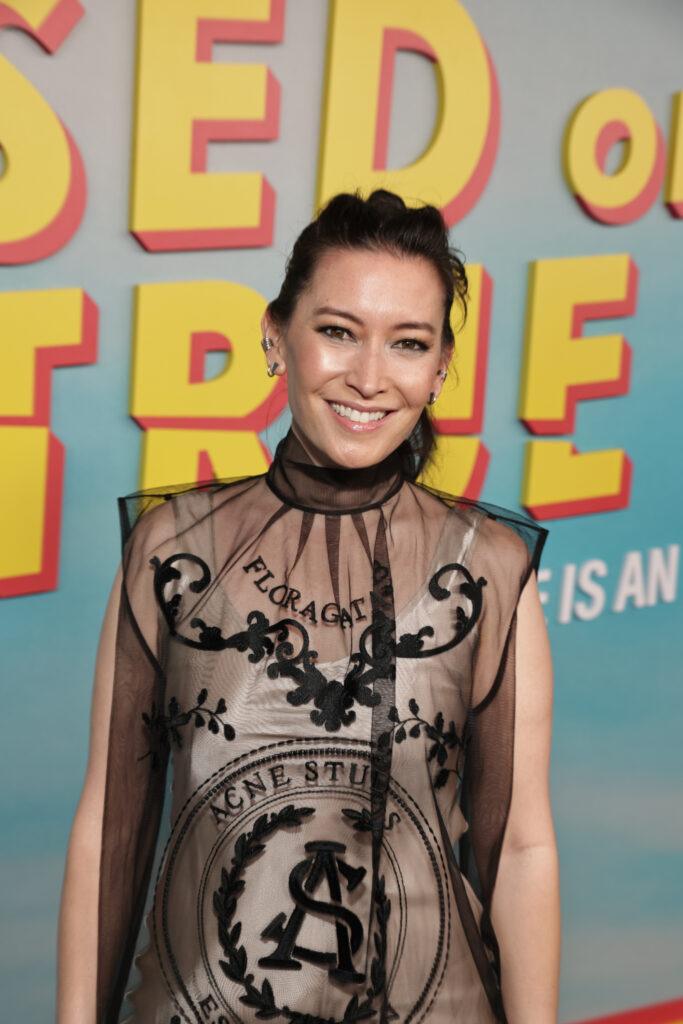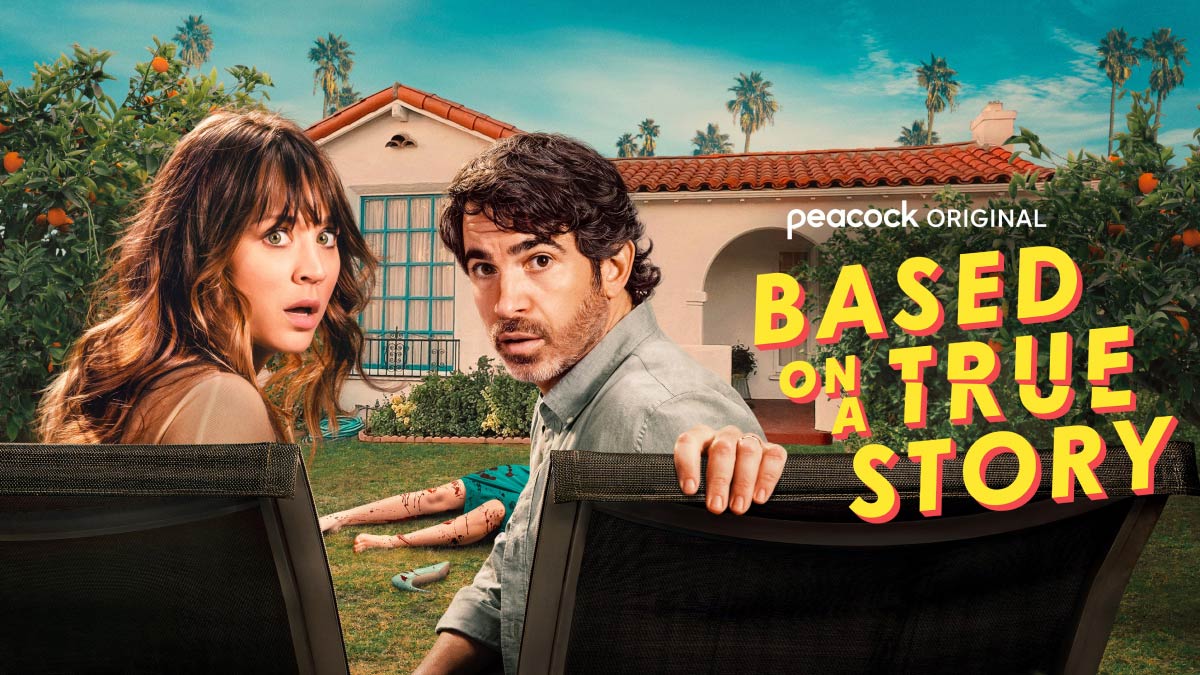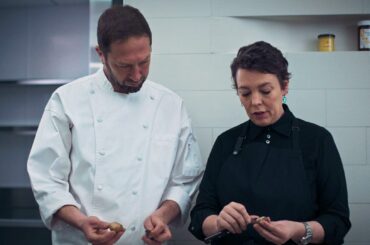
“We always have something to say and sometimes the best thing to say is nothing,” said Based On A True Story composer, Sherri Chung.
Chung isn’t the complete maximalist she jokes she is. The composer acutely knows when to let tracks simmer or settle, to help turn the knife or sell a joke. In Based On A True Story, she does both by landing gags and stabs.
In the Craig Rosenberg-created dark comedy, Chung’s score is, above all else, fun and funky. It’s fast, sort of a maniacal laugh embodied in tracks ranging from piercing strings to overbearing synths. Like the serial killer (played by Tom Bateman) in the series, Chung’s sense of humor remains strong even when it’s practically raining blood in the show.
Recently, the composer behind Blindspot, Kung Fu, and Gremlins: Secrets of the Mogwai spoke with Immersive about her Emmy-contending Based On A True Story score.
[Note: This interview has been condensed for clarity and length]
Before we dive into Based On A True Story, let’s of course talk about Robin Hood: Prince of Thieves, a big inspiration for you as a kid. As an established composer, how do you hear that score differently now?
I say this very gently, very, very timidly, very hesitantly, I do think that at least by today’s standards, the score is probably a little big for some moments of the film itself. I attribute that more to the film not being big enough., know what I mean? I still think the score is flawless, but by today’s practices, the score probably does seem a little bit too dramatic for parts of the story. Maybe for the execution of the story, but honestly, it still inspires me. I still listen to it. I still aspire to write themes as good as that and have an orchestration that is that effective. The movie’s a little laughable and funny, but the score is still an inspiration.
Thank you for indulging that question. When you read the Based On A True Story scripts, what were your initial instincts for the score?

My brain immediately went to noir, private eye trench coats, typewriter, dark alleyways, funny accents, things like that. I wouldn’t say that in execution the score is that, but it’s like my little spin on that kind of music. In terms of the talks with Craig Rosenberg, the creator and the showrunner, a lot of it was us trying to figure out what the show was.
Literally that question kept being asked, “What is the show? Is it a comedy? Is it horror? Is it dark? Is it funny? Is it a thriller? What is the show?” He admitted that they were still looking for the tone of the show.
As I was looking for the tone of the music for the show, they were also looking for the tone of the show themselves. We shook hands and agreed that we were going to go down the road of exploration together and figure it out as we went along.
Your score is incredibly propulsive. How did you find the pace of it? It goes 80 miles per hour, but it doesn’t go off the track.
I appreciate hearing that. I’m not going to lie, I’ve noticed that as a writer that I tend to work in these really high BPMs. I don’t know why, or if I work at a low BPM, I’m double timing it, but I tend to work to write in these high BPMs as I feel it. I imagine if somebody is listening to it, they’re also feeling the speed and the freneticism, as well.
I think there were times where I realized it just worked because there were times when I realized it didn’t work. It is either too fast for the scene, too slow for the scene, and I feel you can really tell when something’s too slow when you know that the energy should be picking up. Sometimes it’s about adding more instrumentation or adding more textures or adding more layers and ear candy and sometimes just speed the damn thing up.
For me, the pace of the music is always influenced by the pace of the scene. If there are quick cuts, if there’s a lot of action, if there’s a lot of back and forth with the dialogue, and the pacing of the acting, it always influences me when pacing the music.
What’s a standout example for Based On A True Story?
In that first episode, Ava and Nathan are now in the bedroom and she’s starting to believe that Matt actually is the serial killer. There’s a moment where Nathan actually believes it, and that’s a moment where the music goes into almost his halftime. It’s the moment where the whole thing shifts when Nathan is suddenly on board.
And so, then I drop in the BPM, if you will. It was an idea that Craig had actually had. He was like, “How can we make a bigger shift here?” I could change the instrumentation, I could change the texture. I did all of that, but the biggest shift was actually in dropping out the frenetic and dropping the pace a lot.
You do slow things down. “Bad Dream” is sounds of melancholia, which the show features. What instruments did you want to use to for the melancholic elements of Based On A True Story?
Instruments that had a little bit more of a rounded attack, a softer piano, maybe a keyboard, a synth pad that’s just easy and again, rounded and a more of a pillowy feel as opposed to in the comedic sense when you have a lot of pica because what’s funnier than picado. I also feel like instrumentation-wise for the comedy part of it was making things feel like a very, very tight string.
Any moment anything could snap, we could laugh and have this comedic relief, or it could snap and we’re all going to die, our favorite characters are now going to be slashed by the serial killer. And so, a lot of the idea of, okay, well, what sounds like a tight string? Well, plucking a string, you can’t pluck something unless it’s actually tight or taut.
And then frequency-wise, having instruments that could really cut through and have a very angular pointed attack. And so, things like heavy piano bangs and harp, but on a setting that’s very, it’s again, plucked very tight, maybe with nails or something, or plucked very hard, so it has a louder, more biting tone.
I even put a typewriter in there somewhere because I thought, again, pulling back to my noir feel and just doing a little bit of throwback of that detective work. Also, the typewriter has a very distinct cutting sound, that kind of thing. So, there is a lot of that kind of instrumentation. Like I said, the frequency is cutting through and just something to add tension.
“The Real Killer” is particularly piercing.
I’m glad. It’s something, again, that’s just more, it’s screaming and is almost screaming. It’s just something that’s just almost kind of ugly to listen to, hopefully.
When you’re creating suspense, do you have general rules or your own kind of mission statement of what you want to do and don’t want to do? Is there something consistent throughout all your work of how you approach suspense?
I definitely don’t want to give anything away, and I don’t want to telegraph unless the job is to telegraph. There were times in True Story where we wanted to fake people out. I mean, that’s the thing too, what kind of suspense is it? Is it the suspense that’s going to lead to a jump scare? Do we want that jump?
Sometimes, especially in certain kinds of horror films, let’s say you go in wanting the jump scares, that’s the fun of it. Like, he’s behind the door, she’s going to walk into that room and get her throat cut. You already know that’s going to happen, so the suspense is more like when is it going to happen as opposed to if it’s going to happen.
I don’t know if I have a general rule, but I think maybe, if anything, the general rule is to figure out the answer to that question, what is the level of suspension? What are we tense about? Is it when it’s going to happen or is it going to happen? Maybe answering that question is the biggest one. I just have to ask, what’s the function of the score at this moment?
Did you ever want to tip your hand, musically, during the fantasy or imaginary sequences? Did you want the score to change or shift during those moments of faking out the audience?
No. I remember having a conversation with Craig about this and being like, “Do we want to tip the hand here? Do we want to give it away?” He’s like, “Absolutely not.” We do not want to give it away that it’s a dream or it’s a fantasy. I think in the moment, it really became about scoring what was happening. So there’s a moment when… Gosh, even, well, I guess Nathan’s getting… I’m not sure what we’re allowed to say here…
Let’s call it an intimate moment.
Yeah. I remember having a conversation with Craig about, and just being like, “As an audience, this is very shocking. Are we from an audience point of view, or are we from Nathan’s point of view?” Craig said, “We’re from Nathan’s point of view, and Nathan’s enjoying this.”
There’s even one where we go into the dog’s fantasy. The dog is having a fantasy about what he wishes would happen to his current dog owner. But that was a thing where it was scoring what the audience was seeing. The audience is seeing a man who’s fallen into a fire pit. It was a dog’s fantasy, so it’s rejoicing, triumphant music or something like that. So, it always had to be a conversation for each one to decide what’s the best way to not give away that this is a fantasy. The point of view had to change each time.
Let’s talk about, as you like to put it, “ear candy.” What are some choices in Based On A True Story that really scream what you personally consider ear candy?
I love this question so much because it actually happened, and I didn’t even realize that that happened until you just asked me the question. I’m like, that totally happened. I’ve gone back and listened to the score. One of the main reasons is because I did it a long time ago, and it’s now getting its sort of circuit in being talked about, which is really cool.
Again, I kind of make fun of myself and say that I’m a maximalist, but I like the opposite of a minimalist, too. I just love to put different textures and sounds, and I love to change it up. I find that it’s more interesting to write that way, and it’s more interesting to hear.
I love this project so much because it hits all the things that I love to put into scores, which is weird and zany, funky things, just fun textures and layers that’s not always melody. It’s not always the melody that I like to play around with. It’s in the ways I tried to create a little bit of tension, or at least keep you in this place of do I laugh or do I get disgusted or am I nervous for them? It’s like a nervous laugh almost.
I think one of the ways was to blur the tonality a little bit, the tonal center and just like, okay, is it major or minor? Is it, you know, the tonic and the dominance? You just get the one in the five, so you don’t really have that note in there that makes it major or minor. You just have a lot of tone clusters that just kind of blur whether it’s major or minor. I just really like the idea of having something that’s interesting to listen to that changes with the attention span of a gnat. I don’t like to let things sit for too long.
Being a “maximalist,” you can throw a lot into the kitchen sink and yet make it all very cohesive. How did you do that in Based On A True Story? How did you know when you strike the right balance between all these ingredients?
I would say first and foremost, it’s probably an instinct and a gut reaction like, whoa, that’s too much, or, yeah, I think we can push a little further. It’s like seasoning. I do think that the analytical part comes into play from the years of orchestration and working with the orchestra.
This score, as we can tell, is not so much an orchestral endeavor as it is certainly instrumental, but I wouldn’t say it’s orchestral in that traditional sense. I think in years working with an orchestra, one of the things that you have to learn is not to cloud things too much. You can’t have too many things going on in the base. You can’t have too many things going on in your frequency ranges, because once things add all up, you end up canceling each other out. I think it does apply across the board, whether you’re working with synthesizers or samples or virtual things or live instruments.
The analytical part does come into how much you have going on, and if you’ve got too many things crowding in the space of each other, nothing becomes discernible. And so, the analytical part becomes, when is it too much? It’s when things don’t become as discernible that you intended to be discernible. Sometimes it’s just like, no, I want it to be a mess of shit, and we just go for it.
If you really want something to cut through, and you’re not hearing that cut through, then you have to go in analytically and figure out. Maybe it’s not cutting through because you have this other instrument doing something conflicting in the same frequency range. If you want this melody or this rhythm or this tone to cut through, then you have to clear out and make space for it.
Based On A True Story is available to stream on Peacock.






